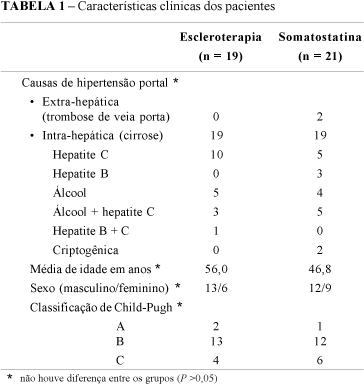The aim of this study was to compare the efficacy of somatostatin versus endoscopic sclerotherapy in the management of digestive bleeding caused by rupture of esophageal varices. Forty patients were evaluated; 21 were randomly assigned to receive somatostatin (initial 250 mug followed by a 48-hour continuous infusion of 250 mug/h and 250 mug 6/6h bolus in the first 24 hours) and 19 to receive endoscopic sclerotherapy with ethanolamine oleate 5%. The patients were evaluated after 48 hours and after 7 days of treatment. Both groups of patients were similar in sex, age, gravity of the hemorrhage and liver dysfunction. Therapeutic failure occurred in 26,3% and 35,7% in the group of endoscopic sclerotherapy (48 h and 7 days respectively), and in 23,8% and 21,4% in the group of somatostatin. The need of blood transfusion (3,38 U in the group of endoscopic sclerotherapy and 2,42 U in the group of somatostatin) and the mortality rate (31,6% in the group of endoscopic sclerotherapy and 28,6% in the group of somatostatin) were also similar (P >0,05). The authors conclude that somatostatin is as effective as endoscopic sclerotherapy and that it should be considered in the treatment of acute esophageal variceal bleeding.
Sclerotherapy; Somatostatin; Gastrointestinal hemorrhage; Esophageal and gastric varices; Liver cirrhosis; Hypertension; portal



